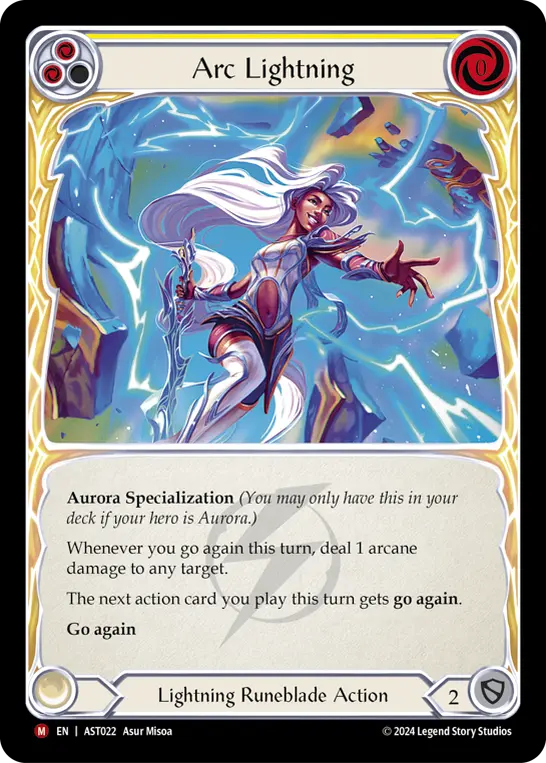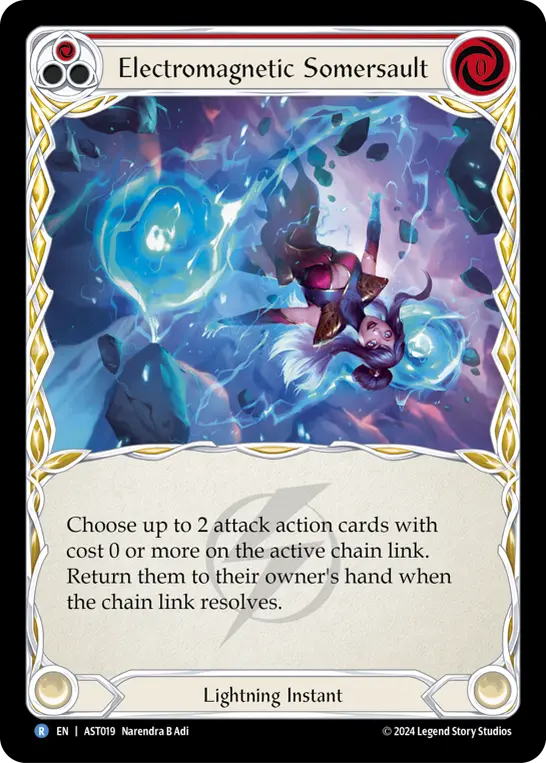In the previous installment of Junior League, I shared how Fai served as an ideal gateway deck for young FAB players. But as you and I know, one of Flesh and Blood's strongest assets is the attachments we form to the heroes; and while my daughter Ivy was able to get on board with Fai from a gamer's perspective, the character art that spoke to her was... less than ideal.

While you'll never hear me speak ill of Rangers, they're ill-suited for teaching the core mechanics of the game to even a precocious child. (There's also the barrier of Lexi's Living Legend status.) Thankfully, Rosetta revisited Aria, and revisited the elemental wayfinder aesthetic through the lens of a Runeblade. Aurora was a perfect stand-in for Lexi, and my daughter was completely sold.

LSS provided a perfect gateway for learning Aurora in the First Strike deck. And make no mistake, this is worth picking up and running a few times to get the basics of. But my goal in this series - and for my daughter - is to get Classic Constructed decks that are both relatively approachable and Armory viable. You'll find that this deck builds upon the First Strike deck in a number of ways - in fact, it uses enough First Strike cards to justify a 2nd purchase.
Before we go on, I'd like to remind you of the Prerequisites I laid out for Junior League - kid-friendly deck building principles that we'll be applying to Aurora's build in a moment.
Prerequisites
These are the skills you want your kid to have mastered before setting them up with their own deck.
1. Simple math: Addition and subtraction are essential to the game, including an understanding of the + and - symbols. It's important that they see how defending is subtracting; how the attack value of a card compares to the defense value on it; and how modifiers impact both sides of the equation.
2. Purchasing: This is the rough concept of resources: that cards have costs, and you need to pay them. It doesn't take much to impress on them that a card that pitches for 3 can pay for a lot of things. (I highly recommend a resource coin such as the ones made by metalfabtokens to keep track of 'floating' resources.)
3. Reading: The level of reading required by a deck can vary widely - and if more reading comprehension is requires on open information sources like equipment and the hero, you can supplement that for them. But they need to be able to read the cards in their hand and understand them. This may seem obvious, but there's a difference between 'able to sound our' and 'able to read in their head' - the latter is needed!
4. Sequencing: Again, the level of sequencing required can vary by deck, but I've found that it's one of the most compelling aspects of the game for my kid, so I wouldn't avoid it. When a deck has broad-strokes goals that you can articulate, they can set themselves to the task of finding how their hand can be placed in an order to make that happen. (For some, a card tray might help here.)
5. Good Sportsmanship: LSS' recent Armory commercial did an excellent job at portraying a realistic first Armory experience: going 0-3. If your kid isn't used to losing games, I advise you stop letting them win; it's important that they learn to find fun in a game well played, not a game won. Check yourself that you're modeling this behavior also.
6.* For lack of a better word, let's call this graphic considerations. Flesh and Blood is rated 16+, and they've taken full advantage of those generous guardrails to deliver a variety of thematic experiences that appeal to an array of players. Some of those are not going to be a fit for your kid - and how they handle that is something you want to be alert to, especially if you're planning to bring them to a public event.
The Decklist

Weapons
- Star Fall (1)
- Reaping Blade (1)
Equipment
- Aether Ironweave (1)
- Hope Merchant's Hood (1)
- Dyadic Carapace (1)
- Grasp of the Arknight (1)
- Nullrune Gloves (1)
- Snapdragon Scalers (1)
Loadout
- Arcane Polarity (Red) (3)
- Arc Lightning (Yellow) (3)
- Burn Up // Shock (Red) (3)
- Channel Lightning Valley (Yellow) (3)
- Fry (Yellow) (3)
- Electromagnetic Somersault (Red) (2)
- Electrostatic Discharge (Red) (3)
- Flittering Charge (Red) (3)
- Fry (Red) (3)
- Static Shock (Red) (3)
- Sizzle (Red) (3)
- Photon Rush (Blue) (3)
- Electrostatic Discharge (Yellow) (3)
- Crackling (Red) (2)
- Heaven's Claws (Yellow) (3)
- Rites of Lightning (Red) (3)
- Sink Below (Red) (3)
- Fry (Blue) (3)
- Photon Rush (Red) (3)
- Second Strike (Red) (3)
- Snatch (Red) (3)
- Sigil of Lightning (Blue) (3)
- Fyendal's Fighting Spirit (Red) (3)
- Lightning Press (Red) (2)
- Heaven's Claws (Red) (3)
Aurora can be built in a variety of ways; but by following a Briar-like aggro strategy, we can create the kinds of rules of thumb that make FAB's turn sequences navigable to a young mind. At the same time, Aurora represented a major step up in the turn-by-turn decision-making asked of her, even as we aim for a more straightforward play pattern.
For one, we now have to consider arcane damage. The concept of arcane had already been introduced through opponents Ivy was facing at Armory events. But now this was something her deck was capable of doing. When you play an Arc Lightning before throwing Rites of Lightning with fusion, there are 3 separate damage instances to track - but she quickly caught on to this 'bonus damage' as it sparked out in front of her attacks. (I think it helps to use visual language when talking about game mechanics, and in this instance it's easy to conceptualize sparks flying ahead of Aurora's actual attack.)


As with many aggro decks, we can keep purchase costs low in deck building - but Aurora adds the interesting layer of her weapon and hero ability. If we have a card that doesn't suit our turn, we can pitch to create an Essence of Lightning and stock go again for a future turn. This can also enable some really cool combo turns - Snatch is a prime example. What I like about the impact of Aurora's power is that it leads Ivy to think through the outs that might be available to her in a turn; this outside-the-box problem solving will be foundational to her ability to later step into more complex heroes.


Transitioning from Fai, the sequencing for Aurora is only slightly more complex. We're using less shorthand when reading cards now, as many elemental requirements are slightly different from one another. Do you need to play a Lightning card first, or reveal one from hand? Maybe it's looking for you to have dealt damage already, or maybe it's asking about an Instant (we'll approach those shortly). We still have that capital G vs. lower case g to cue us toward a prerequisite, but the specifics are much more varied than Fai's 'Draconic/red' - which were nearly always the same cards anyway.
And while Fai was a deck that used quantity of attacks to overwhelm the opponent with combat chains that just go too wide, Aurora shows some care for quality of attacks - especially as we get into the on-hit effects of Burn Up and Channel Lightning Valley.


In Flesh and Blood, 4s matter - and this is a deck that teaches that in really interesting ways. Crackling and Second Strike both climb from easy-to-block 3s to irritating 4s when their prerequisites are met; the Lightning buffs similarly bring filler cards like Fry (Y and B) to a critical threshold. Oftentimes, the difference between a 3 and a 4 is whether or not the attack is free; that resource cost buys a better attack, and now we have decision points in the hand.


Instants add a new level of complexity to the deck, but they feel so good to play that there was really no way to leave them out. For many, the distinction between Instant and "Action with go again" is negligible: Channel Lightning Valley, Electrostatic Discharge, and when we're not being tricky, Sigil of Lightning. Lightning Press is basically an attack reaction.
But where things get complicated is where they also get so rewarding. Flittering Charge wants us to play Instants while it's attacking to pick up go again; this is a prerequisite that's easily taught, and satisfying it always makes a young FAB player feel cool.


But Electromagnetic Somersault stands on its own. Once you teach them how to play this one out - first on an attack to reuse it, then on defending cards to recover them - the whole deck opens up to them. We all know the crushing feeling of being forced to defend with your best aggro cards. What if you could just take them back when you're done blocking? This is true power, my friend.
When choosing an equipment suite, I usually work from the assumption that this deck is being built by someone with a larger collection to support the player, and that they won't be running the same class at the same event. Grasp of the Arknight and Dyadic Carapace should come from your collection, or they should simply be more affordable alternatives such as Nullrune Robe and Aether Crackers. Hope Merchant's Hood is a great out for those all-Instants hands that can't block; giving agency to overcome RNG is worth it for this demographic.
You'll note a few compromises have been made with the decklist. Notably, we're not packing Gone in a Flash. Make no mistake, if this card comes down in cost I'll be putting it in; but for the time being, I just can't justify the added expense in tandem with the added complexity. Channel Lightning Valley only recently made the list, largely because I can help maintain it from the other side of the table; if you're aiming to keep costs down and lower overall complexity, you can replace that one with another Instant (yellow Lightning Press is a fine alternative).
Another compromise: we're not running Runeblade cards. This is that item 6: Graphic Considerations on the guidance we prefaced this with. Runeblades have some of the creepiest art in the game, and no matter how useful the card was, it wasn't going to be worth making the 6-year-old pilot uncomfortable with the artwork in her hand. (Conversely, the fuzzy friend on Crackling is the primary reason the card has made the cut time and time again. We all need pet cards.)

Aurora was a leap, make no mistake. The timing windows for Instants could have easily been a stumbling block (and if she were playing in a more serious environment, we'd have a lot more work to do there); the sequencing and prerequisites required for a successful turn are a challenge; and there are inherent feelsbad moments with so many 0-blocks in the deck. But Ivy has proven up to the task, showing that when you give them the opportunity, young players can rise to complex tasks. This was, in no small part, motivated by a personal interest in the hero, and I'm glad we went for it - but next time, we'll examine a deck that's a little more straightforward.




